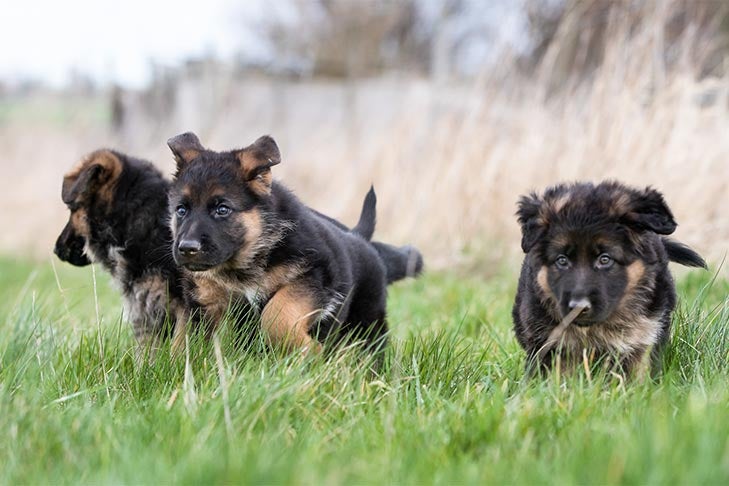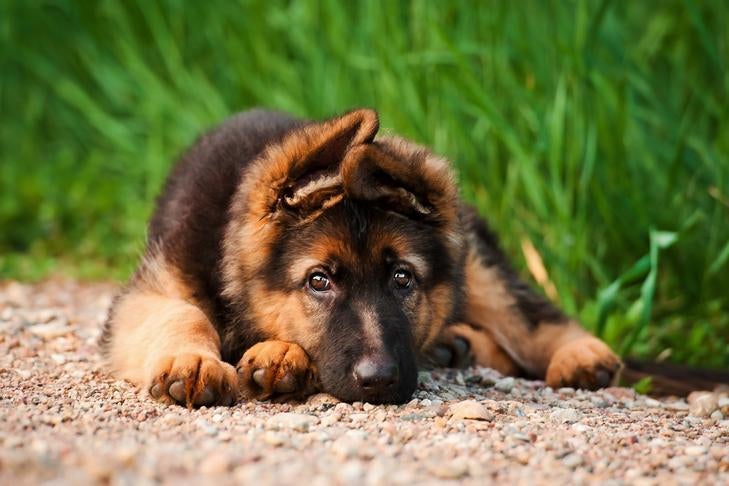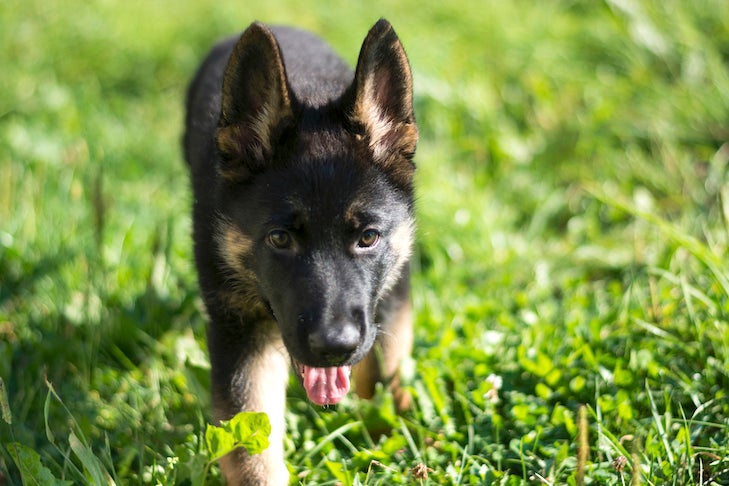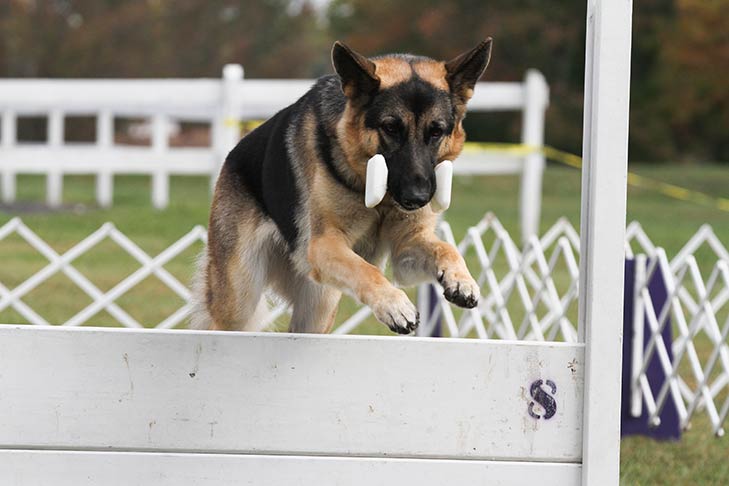
A well-trained German Shepherd Dog (GSD) is a joy to live with, one of many reasons why this is America’s second-most popular dog breed. Making sure you bring out the best of this remarkable breed starts with puppy training, when your GSD is most impressionable.
Finding a Puppy Who Is the Best Fit for You
Finding a good, ethical breeder is one of the most important ways to ensure you are getting off to the right start in obtaining the puppy who will be the best fit for you and your household. Breeders observe their puppies’ personalities and drives and can match the right puppy to the right individual or family.
You may also wish to acquire a puppy from one of the breed-rescue organizations listed in the AKC Rescue Network; currently, over 40 GSD rescues are listed, a testament to the popularity of this magnificent breed. If you choose this route, be sure to discuss with the breed rescue organization your needs and what you are looking for in a puppy; they should also be able to help you find the puppy whose temperament and personality will be the best match for you.
Nadia Adams of Oher Tannen German Shepherd Dogs has been a GSD breeder for 15 years and comments, “A well-bred German Shepherd Dog is highly intelligent, thriving on praise and wanting to please the owner. This combination makes them very trainable, which is one of the most appealing qualities of the breed.”
This breed’s high level of intelligence and strong willingness to work mean your GSD must receive consistent and ongoing training from an early age. A bored GSD is a destructive GSD. “That said,” states Adams, “the sky is the limit, if the owner ca devote a good amount of quality time to the dog, especially during the critical first year of life.”
You can use this timeline as a guide to make sure you are hitting all the right target goals during the crucial stages of your puppy’s life.

From 8 to 16 Weeks
Training Goal #1: Socialization
Puppies of all breeds have a critical socialization window that closes at 12 to 16 weeks of life, and your GSD puppy is no exception. In fact, for GSDs, who by nature are protective guardians, socialization is extra important so that your puppy learns which strangers are friendly and not a threat.
GSDs are very observant, and your puppy will pick up on your cues and reactions around new people and new situations. During this critical period, having exposure to many different kinds of people in non-threatening situations will help your puppy be confident among friendly strangers rather than fearful or aggressive. And even during times of social and physical distancing, you can still socialize your puppy safely.
Proper socialization cannot be overemphasized for this breed; as Adams notes, “The foundation for most training is confidence. It is critical that the GSD puppy is well socialized from an early age onward. Safely exposing the puppy to new sights, sounds, and smells is absolutely critical for development. Good socialization translates to confidence.”
Certified dog trainer and CGC evaluator Jacqui Foster, CPDT-KA, echoes this sentiment: “I tend to lean more towards developing self-confidence in the puppy. For this I recommend short, fun, three-minute games that engage the puppy with the owner as well as in noises, weird and uneven surfaces, family members, etc., throughout the day. A confident puppy is a happy puppy.”
During this period, be sure to expose your GSD to the many different elements of daily life and routines you will want them to take in stride as adults. For instance, GSDs need regular grooming to control shedding and maintain coat and skin health, particularly during those seasonal times (usually twice a year) when these dogs “blow their coats.” So you should introduce your puppy to basic grooming tools, like combs, brushes, and nail clippers, early on—going slowly at first and making it a fun experience.
Training Goal #2: Crate Training
This is also a good time for crate training, which Adams recommends as well. GSD trainer and dog sports enthusiast Alexa Hagood, LVMT, agrees: “Crate breaks, even when brief, can help the puppy become acclimated to going in the crate and having some alone time.” She notes that this can help reduce the risk of a puppy developing separation anxiety, and recommends beginning with using the crate for feeding times (for five to ten minutes inside the crate), and at times when the owner needs to do daily chores.
Training Goal #3: Housetraining
Crate training is an invaluable tool for facilitating housetraining, which almost all GSDs take to quickly and easily. In fact, many GSD owners will find that this is one of the easiest breeds to housetrain, as long as constant supervision and consistency are provided.

From 3 to 9 Months
Training Goal #1: Begin Obedience Training
The German Shepherd Dog’s work ethic is legendary, and you can encourage your dog’s best working traits with early and ongoing training. GSDs excel at obedience, so begin teaching your puppy basic commands like sit, down, and stay, as well as loose-leash walking, from an early age. Enrolling in a puppy obedience class can be extremely helpful both for teaching these commands as well as socialization, and it’s not too early to begin thinking about CGC training as well.
Training Goal #2: Recall
Begin teaching your GSD to come when called as soon as possible. It takes a lot of time, practice, and patience to get a reliable recall, but this skill is well worth it, as it is one that may save your dog’s life one day.
Training Goal #3: Impulse Control
Learning to control their impulses is important for all puppies, and for the GSD, it can be one of the most important ways to curb problem behaviors to which this breed is prone if allowed to become bored: behaviors such as excessive barking, digging, aggressive chewing, and inappropriate chasing (due to their prey drive, GSDs have been known to chase everything from cats to cars).
The key to impulse control is getting your dog to focus on you. This will have beneficial effects for all the rest of your training efforts, especially in AKC dog sports like Obedience and Rally.
Require that your puppy sit before getting food, playing with an exciting toy, going outside to play, or any other favorite activity. As your GSD puppy advances in obedience training and knows more commands, you can require more advanced commands or tricks in order to receive treats or play.

From 9 Months to 24 Months
Dogs of different breeds and sizes mature at different ages, and while one year of age is commonly considered the end of puppyhood in general, a German Shepherd Dog may not reach an adult level of maturity before the age of two or three (and males tend to reach this stage later than females). So continuing to work on impulse control, improve obedience skills, and advance to training in more focused activities like tracking, scent work, protection work, agility, and herding—all of which (and more) are capabilities of this breed—must continue throughout this period and then be reinforced as your GSD reaches adulthood. This is also a good time to transition from puppy food to a large breed dog food.
Keep in mind that this is a breed that thrives on constant and consistent work and training, and loves to have a job—or many jobs!—to do. If you can provide your GSD with outlets for their intelligence and versatility, both you and your dog will reap the rewards.
Yasmine S. Ali, MD, is a cardiologist and writer based in Tennessee, where she lives with three Canine Good Citizens, including an AKC-registered German Shepherd Dog.

